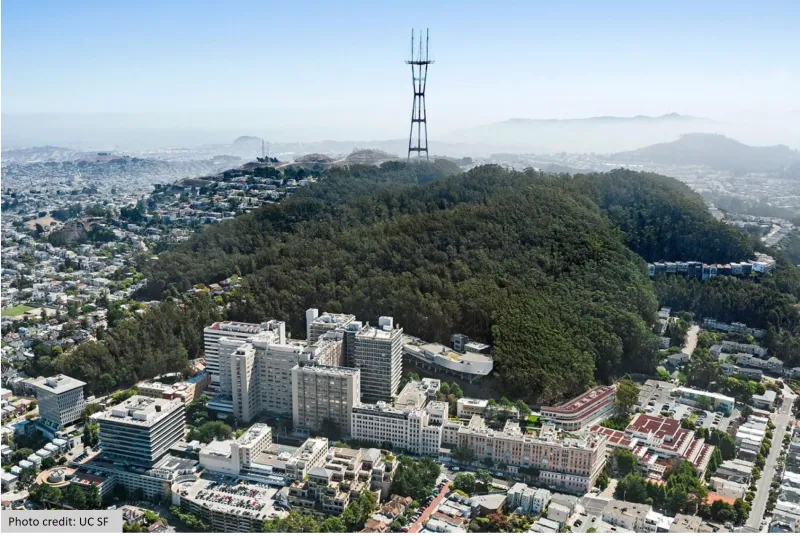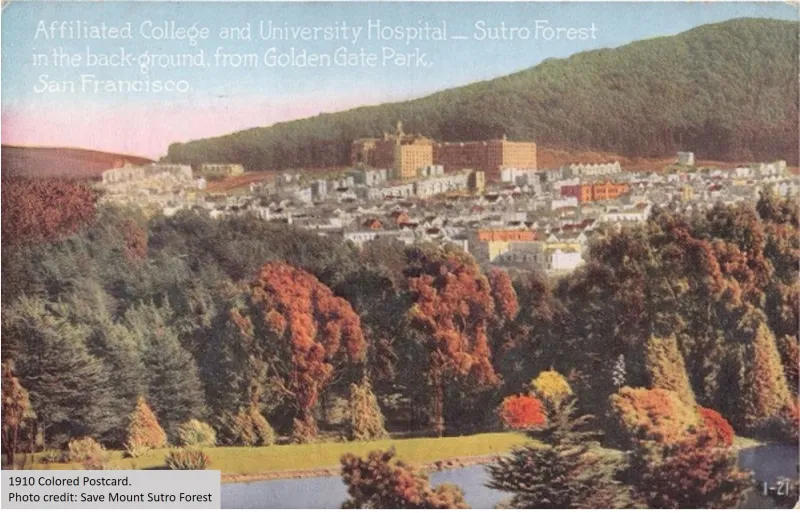Mount Sutro
Background
The Mount Sutro Open Space Reserve (Reserve) was designated in 1976 as “permanent open space to be kept free of any permanent structures or facilities except footpaths and appropriate landscape construction intended to enhance its use as a natural area” (HortScience et al., 2017). Initially called Mount Parnassus, and historically owned by Adolph Sutro, the Reserve expands 61 acres, and is among the tallest points in the city, with an elevation of over 900 feet. Since Mr. Sutro was a great believer in the idea that for every tree that is destroyed two should be planted, in the late 1880’s tree planting efforts established blue gum eucalyptus (Eucalyptus globulus), Monterey pine (Pinus radiata), and Monterey cypress (Hesperocyparis macrocarpa) stands (HortScience, 2017; Save Mount Sutro Forest, n.d.). The reserve is currently characterized by large assemblages of continuous eucalyptus cover. Since eucalypts trees were very successful in adapting to local environmental conditions, they became the dominant species (HortScience et al., 2017).

The site is important for a number of reasons. Ecologically, it represents an area characterized by majestic groves, home to numerous plant, and animal species. In 2010, over 120 plant species, and more than 100 species of birds, 15 mammals, reptiles, and amphibian species were identified within the Reserve. Culturally, it represents a remnant of an emblematic landscape, a landscape that is intrinsically tied to the history of the city (Mount Sutro in the backdrop of the 1910 postcard displayed below).

In 1998, the University of California San Francisco (UCSF) embarked on a mission to create a management plan for the 61 acres that the University owned referred to as Mount Sutro Open Space Reserve (Sutro Stewards, 2017). UCSF acquired the property in 1953 (Alexander, 2016). Throughout the years, numerous plans have been focused on designing management actions to restore the original ecology of Mount Sutro. However, the implementation of proposed actions has been delayed due to widespread controversy regarding the best course of action. The most recent Vegetation Management Plan (the Plan) was prepared by HortScience and finalized and revised in January 2017.
The goal of the Mount Sutro Vegetation Management Plan was to enhance the aesthetics, and plant community health of the Reserve, by creating a mosaic of trees, shrubs and ground cover of different types (HortScience, 2107). Specifically, the objectives were twofold. First, management activities were focused improving the distant view of the Reserve from outside locations. Second, the Plan aimed at improving the experience of being in the Reserve by creating a mosaic of trees, shrubs and ground cover of different types, and creating canopy gap opening that would offer scenic views of the surrounding area and of the city.
The Vegetation Management Plan was composed of four different sections focused on 1) Reserve and ecosystem health, 2) visual design and aesthetics, 3) public safety, and 4) public access. The desired outcome of active management actions was to maintain a “forest experience”. In order to achieve this goal, a thorough assessment of existing conditions was conducted. This assessment documented the topography of the site, the climate of the area, the soil types, as well as the plant and animal species found in the Reserve.
Existing Conditions
Tree assessment was focused on measuring the diameter at breast height (dbh) of trees within the Reserve, determining whether a tree was alive or dead, and assessing crown characteristics (in terms of live crown cover and crown class). Based on the crown class, stands were classified as dominant, codominant, intermediate and suppressed (HortScience et al., 2017). Four distinct forest types were identified based on tree species composition, tree health, location history, and aspect (HortScience et al., 2017). All four types differed in density and stand structure, and were dominated by blue gum eucalyptus.

Forest type 1 (roughly encompassing 24 acres) was characterized by visible death of upper crown, having trees with less than 25% live crown.
Forest Type 2 (9 acres) had a tree density of 45 trees per acre (primarily blue gum eucalyptus – 88%). The slopes within this forest type ranged from 20% to over 70%.
Forest Type 3 (8 acres) was characterized by trees that ranged in size from 2” dbh to over 40” dbh.
Forest Type 4 (18 acres) was characterized by having the healthiest trees in the Reserve, with live crown canopy cover with ratio of 40% or greater.
The forest structure was characterized by a mosaic of species within various age classes, characterized by an array of patch, stand sizes, and canopy gaps. There was also a significant amount of standing dead, and downed woody plants. Numerous plants established in the overstory, understory or part of the gourd cover contribute to the diversity found within the Reserve (HortScience, 2017).
One of the main conclusion of the assessment indicated that the health of the eucalyptus stand has declined over time due to insect and disease pressures, prolonged droughts, and high stand density (with little or no regeneration occurring at the time when the study was conducted). From 1999 to 2016, a significant number of small trees have died, and large trees have declined in health. In addition, the dense forest floor prevented seeds from germinating, and seedlings from developing (HortScience, 2017). In addition to this, the vegetation in the Reserve was not very diverse, nor very healthy (HortScience, 2017). The findings of the study suggested that approximately 140 plant species were found in the Reserve (more than in 2010), of which 57 non-native species. Among the non-natives present, roughly half were considered invasive, and were found to interfere with the regeneration of tress by outcompeting natives and blue gum seedlings and saplings (HortScience, 2017). In the absence of active management, assuming that current conditions persist, the study predicted that the loss of large trees will not be replaced, and the ecosystem will become dominated by shrubs and vines such as ivy and blackberry. Therefore, immediate intervention was thought to be necessary.
Recommendations
The recommended management actions concluded from the assessment suggested the following:
- Increase biodiversity of vegetation.
To enhance structural diversity within the Reserve and to create new environments for the ground cover vegetation, management actions should focus on creating a canopy structure of different tree species. To increase the diversity of species, and promote stand age and patch structure diversity, planting of species such as Monterey cypress, Monterey pine, coast live oak, California bay, coast redwood is encouraged.
- Promote native vegetation.
The Vegetation Management plan highlighted the importance of native vegetation in maintaining a balanced and diverse ecological community. The Plan called for retaining native plants during the regeneration operations coupled with extensive monitoring of native plant and bird species. The removal of non-native and invasive vegetation such as acacia, ehrharta, blackberry, ivy and other vine species is encouraged.
- Improve plant regeneration/recruitment
The Plan suggested creating openings in the canopy to provide full-sun growing conditions for the understory vegetation. The Plan recommended planting new trees in the winter during the rainy season (since irrigation is not presently available in most areas of the Reserve). Additionally, regeneration of blue gum stands is desired. To help achieve this, management efforts should focus on clearing and maintaining competing vines and vegetation, and thinning existing stands and removing trees to create canopy openings allowing the sun to reach the forest floor.
- Manage insect and disease pressure
Recommendations to help better manage insect and disease pressure suggest undergoing tree removal or planting within the Reserve during the winter months, when the insects are not active, as well as thinning existing stands, and removing competing vegetation to reduce water stress.
- Improve the structural diversity within the Reserve
This recommendation can be a results of increasing the diversity of species. Still, silvicultural treatment is encouraged since under ideal conditions, the forest should have many more trees in small diameter classes than large diameter classes (distribution difficult to attain without active management actions).
To achieve the objectives previously discussed, the silvicultrual treatments recommended by the Vegetation Management Plan include: removing individual trees through the individual tree selection method; creating small opening of 2.5 acres or less by removing dead or unhealthy vegetation using the group selection method, and maintaining healthy tress, while removing structurally unsound trees through the seed tree method.
A more in-depth vegetation management plan is broken into three different phases. The first phase describes management recommendations that would need to take place in the first five years, phase two takes place between six and ten years, and the last phase, phase three, provides a long term outlook, providing management recommendations for 11 and 20 years in the future. The overarching recommendations that span across all three phases include the following: continue to manage tree risk; initiate forest treatments; continue to enhance restoration and stewardship of native plants; continue to enhance defensible space between buildings and Reserve vegetation; and continue to manage and maintain trails and public access (HortScience, 2017).
Lastly, monitoring is viewed as a critical, and integral part of the Vegetation Management Plan. Comparing the initial conditions with the conditions developed as trees mature provides a valid assessment of the effectiveness of specific treatments. Since the success of management actions can only be assessed over time, monitoring efforts should be dedicated towards revisiting forest inventory plots established in 2016, and recurrent monitoring individual treatments upon completion of restoration activities (HortScience, 2017). For more details pertaining to Mount Sutro management initiatives through time, the Mount Sutro Open Space Reserve Documents provides a comprehensive overview.
Risk and Communication
The Vegetation Management Plan prepared by HortScience (2017) for UCSF, provides a comprehensive assessment of existing conditions coupled with management recommendations to revive Mount Sutro forest. To improve forest health, reduce the risk of wildfire, and restore native vegetation, the management activities proposed involved thinning of the forest by removing understory plant species (mostly invasive species), and cutting down a significant number of mature eucalyptus trees. Increasing the spacing between trees, and creating canopy openings is thought to significantly help regeneration of vegetation, and help seed recruitment by allowing the sun to penetrate the dense canopy and reach the forest floor.
Similar to previous plans (2001 and 2013), this initiative was faced with significant public opposition and backlash, sparking controversial disputes, and delaying the implementation of forest thinning operations (Bricker, 2013; Sussman, 2016). Opponents argue, that the forest represents a landmark with lush vegetation and century-old trails that should be kept in its current state, emphasizing that "its density is one of its beauties" due to the rarity of such forests in the City (Nance, 2014).
The debate over how to best manage this urban forest has brought together numerous groups highly concerned about UCSF’s plans to remove eucalyptus from the Reserve. Groups such as Save Sutro Forest became established. Environmentalists and locals are deeply concerned that the proposed tree removal operations will create a more vulnerable, weaker forest, instead of a healthier one. With the majority of large trees gone, and with the introduction of native plants primarily shrubs and herbs, the Sutro forest is thought to transform into an undesirable state, a shadow of its current self (Save Sutro Forest, 2017). A draft Environmental Report was conducted in 2013 , yet organizations such as the San Francisco Forest Alliance critiqued the report for being misinformed and inconclusive, raising concerns that the possible benefits of this project are unclear or unlikely, while the effects are significant (San Francisco Forest Alliance, 2017).
